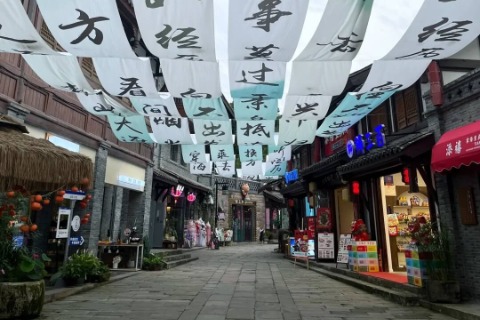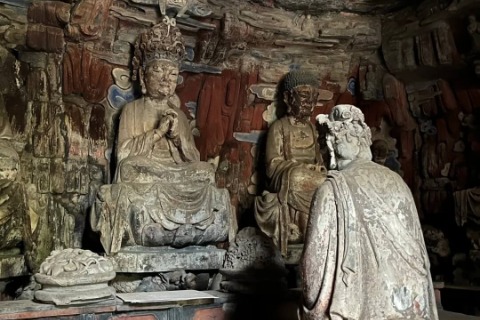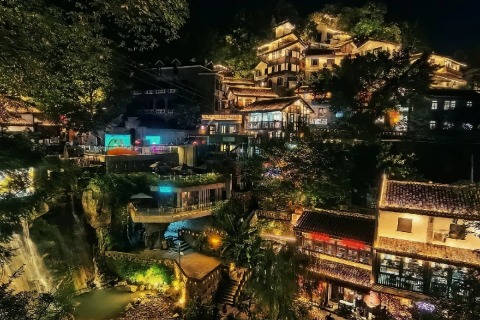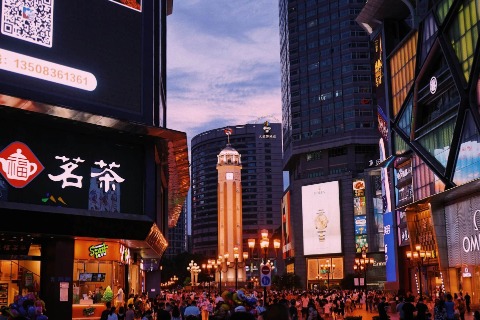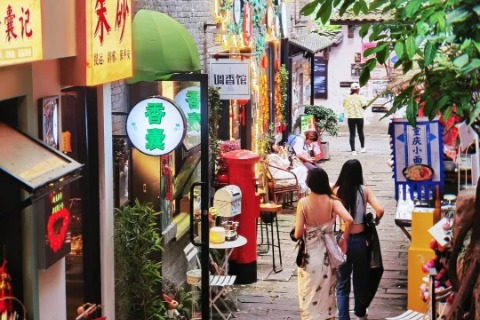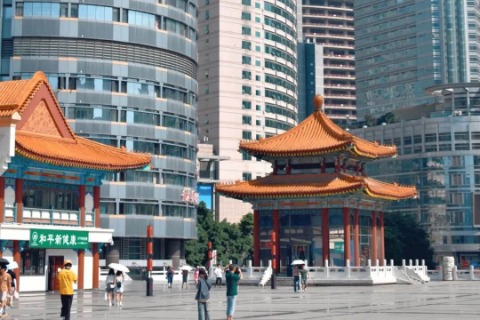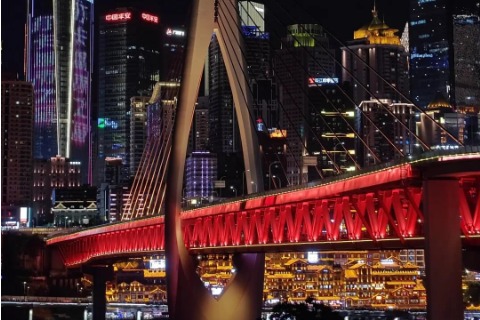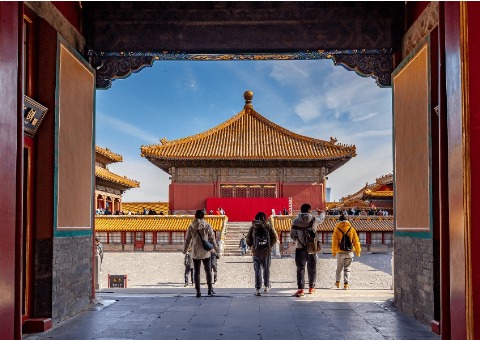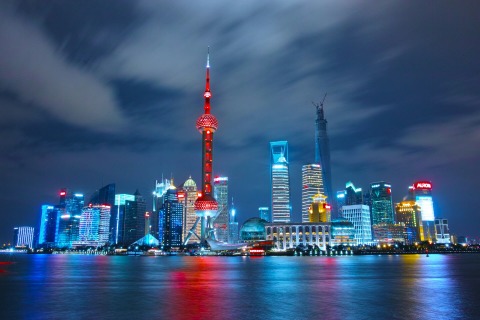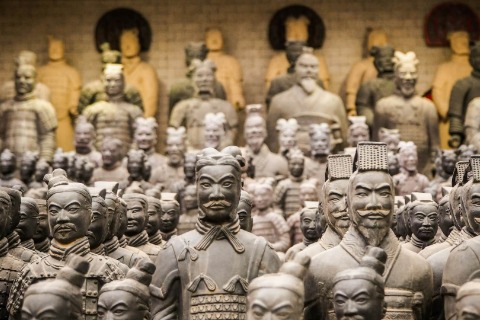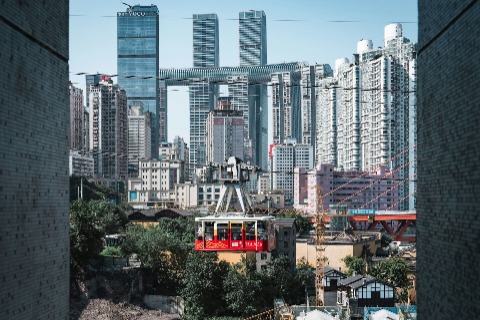Chengdu Wu Hou Shrine
“Wu Hou” refers to Zhuge Liang, who was an outstanding politician, military strategist, inventor, and writer in ancient China.
The Chengdu Wu Hou Shrine (武侯祠) was established in 221 AD, originally dedicated to commemorating Zhuge Liang. Over time, it evolved into a shrine honoring both the monarch and his ministers, becoming an important site for remembering heroes of the Shu Kingdom during the Three Kingdoms period, including Emperor Liu Bei and Prime Minister Zhuge Liang. The Chengdu Wu Hou Shrine (武 侯 祠) is not only a symbol of Three Kingdoms culture but also the only shrine in China dedicated to both a monarch and his minister. “Wuhou” refers to Zhuge Liang, who was an outstanding politician, military strategist, inventor, and writer in ancient China.
Inside the shrine, there are many historical artifacts and memorials that showcase the history and culture of the Three Kingdoms period. Additionally, the Chengdu Wuhou Shrine (武侯祠) hosts various cultural activities, such as performances themed around the Three Kingdoms and innovative interactive experiences related to intangible cultural heritage, attracting many visitors to explore and engage.
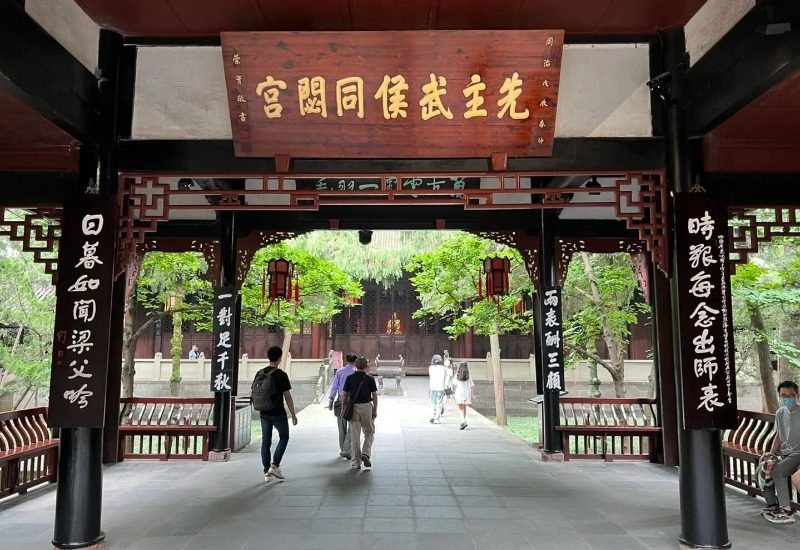
Table of Contents
Highlights of the Chengdu Wu Hou Shrine
General Corridor & Civil Official Corridor (Chinese name: 武将廊&文臣廊)
The General Corridor at the Chengdu Wuhou Temple honors fourteen military generals from the Shu Kingdom during the Three Kingdoms period, including Zhao Yun, Sun Qian, Zhang Yi, Ma Chao, Wang Ping, Jiang Wei, Huang Zhong, Liao Hua, Xiang Chong, Fu Qian, Ma Zhong, Zhang Yi, Zhang Nan, and Feng Xi.
Located to the east of the General Corridor, the Civil Official Corridor features statues of fourteen civil officials, led by Pang Tong, also known as “Feng Chou.” The figures include Pang Tong, Jian Yong, Lu Kai, Fu Rong, Fei Yi, Dong He, Deng Zhi, Chen Zhen, Jiang Wan, Dong Yun, Qin Mi, Yang Hong, Ma Liang, and Cheng Ji.
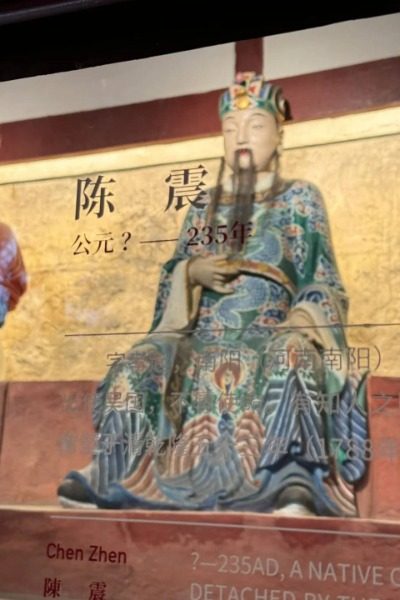
Liu Bei Hall (刘备正殿)
In the center of Liu Bei Hall, there is a gilded statue of Liu Bei, approximately 3 meters tall. The statue depicts him wearing an imperial crown and a golden dragon robe. Throughout his life, Liu Bei fought across much of China, enduring many hardships, and ultimately established the Shu Kingdom with the assistance of Zhuge Liang.
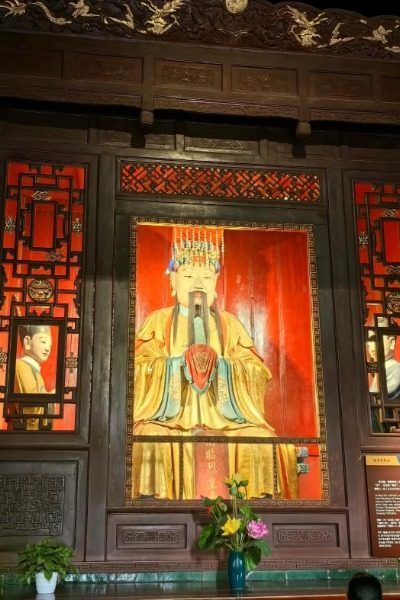
Zhuge Liang Hall (诸葛亮正殿)
In Zhuge Liang Hall, there are statues of Zhuge Liang and his three generations. On either side of Zhuge Liang’s statue are figures of his son, Zhuge Zhan, and his grandson, Zhuge Shang.
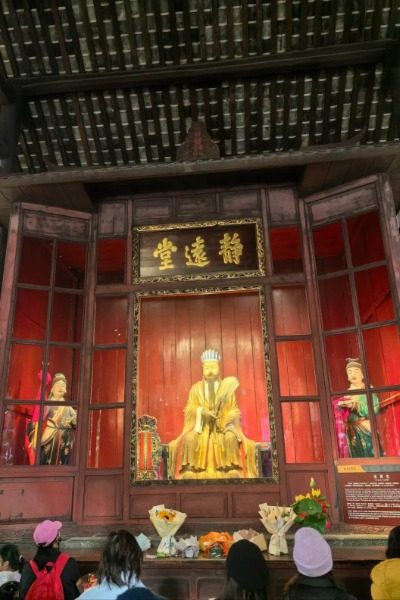
San Yi Temple (三义庙)
The name of San Yi Temple is derived from the story of the “Oath of the Peach Garden,” symbolizing the deep friendship among Liu Bei, Guan Yu, and Zhang Fei. Inside the main hall, there are clay statues of Liu Bei, Guan Yu, and Zhang Fei, with Liu Bei’s statue standing 2.8 meters tall and those of Guan Yu and Zhang Fei at 2.6 meters. In the worship hall, black marble relief carvings depict scenes from the “Oath of the Peach Garden” and “The Three Heroes Fight Lu Bu.”
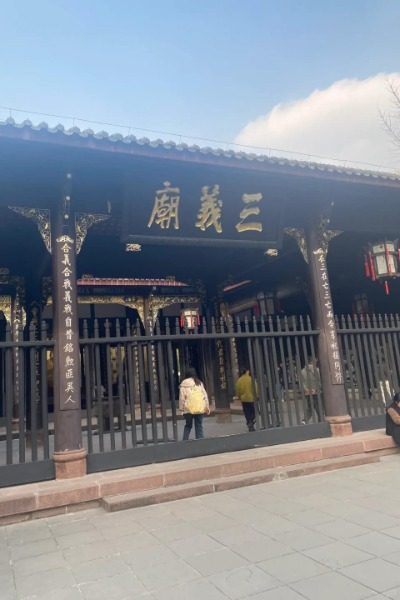
Peach Blossom Garden (桃花园)
The Peach Blossom Garden boasts beautiful scenery with a variety of elements, including flowers, trees, intricate carvings, gentle streams, lotus ponds, red goldfish, and pavilions. The story of the “Oath of the Peach Garden” is a famous tale from the classic Chinese literature, Romance of the Three Kingdoms, depicting Liu Bei, Guan Yu, and Zhang Fei swearing brotherhood in a peach orchard. The garden at the Chengdu Wu Hou Shrine recreates this historical scene with three modern sculptures representing the three men during their oath-taking. These sculptures are made from three different colors of stone, symbolizing friendship among different cultures.
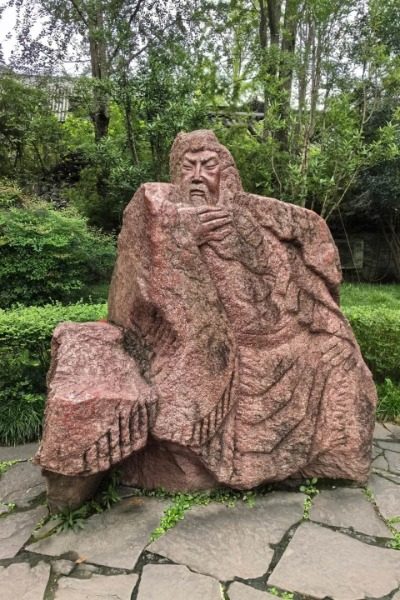
Mingliang Qian Gu Exhibition (明良千古展)
The Mingliang Qian Gu Exhibition is a permanent exhibition at the Chengdu Wuhou Shrine, which took eight years to prepare. This exhibition fills a gap in China, as it is the first special exhibition dedicated to the historical figures of Liu Bei and Zhuge Liang. Through the display of artifacts, it outlines the extraordinary era of heroes during the Three Kingdoms period and highlights the legendary lives of Liu Bei and Zhuge Liang.
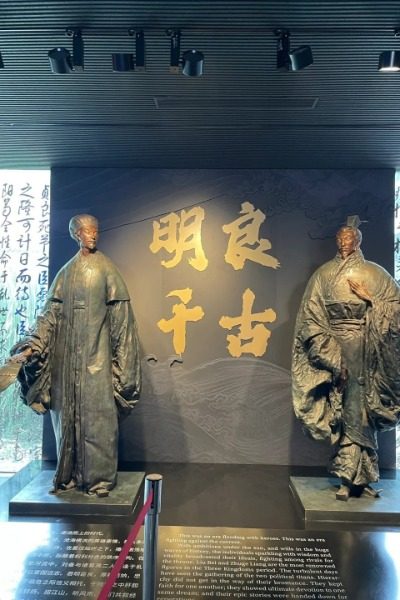
Kongming Garden (孔明苑)
Kongming Garden is a landscaped courtyard dedicated to commemorating Zhuge Liang. The design features a typical “Shu Kingdom” style, with artificial hills, lush trees, and serene pathways, adorned with large flags bearing the character “Shu.” The garden showcases various exhibits related to Zhuge Liang, including replicas of Zhuge’s camp, Zhuge drums, and Kongming locks, allowing visitors to appreciate the rich heritage associated with this legendary figure.
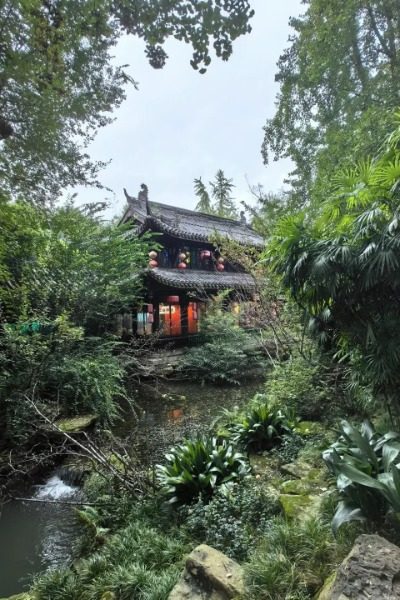
Red Wall Corridor (红墙夹道)
The Red Wall Corridor at the Wuhou Temple is a popular spot in Chengdu, especially loved by photographers and tourists. This corridor is not only part of the shrine but also a symbol of Three Kingdoms culture. It has witnessed the rise and fall of the Shu Han dynasty and embodies the wisdom and loyalty of Zhuge Liang. The design of the corridor is clever, with tall green bamboos flanking the high walls, creating a harmonious beauty that blends history with nature.
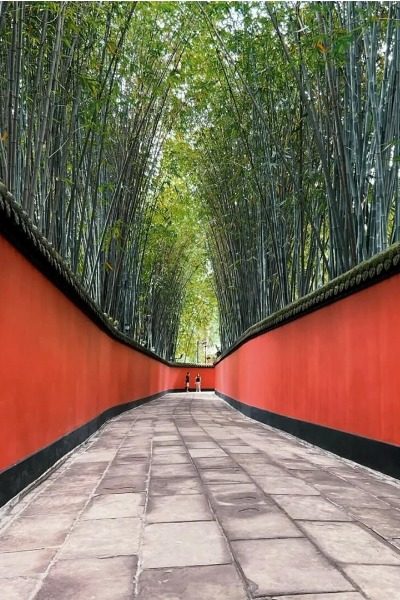
Huiling Tomb (惠陵)
Huiling is the joint tomb of Liu Bei and his wives, Lady Gan and Lady Wu. Liu Bei passed away in 223 AD in Baidi City and was later transported back to Chengdu for burial, making it the only royal tomb from the Three Kingdoms period. The architecture of Huiling includes a screen wall, mountain gate, spirit path, and main hall, covering an area of 2,000 square meters.
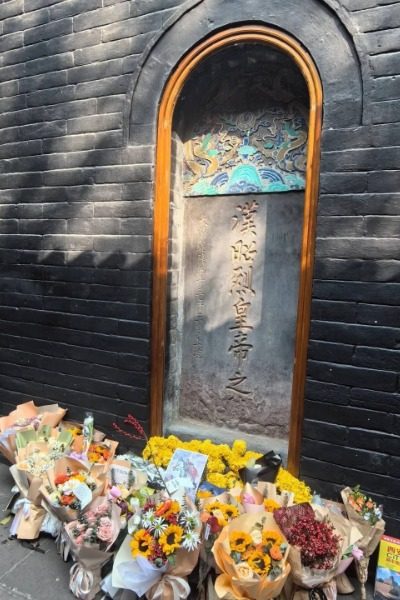
Nanjiao Park (南郊公园)
Nanjiao Park was originally the burial site of General Liu Xiang, who fought against the Japanese. Although it began as a cemetery, the overall architectural style of the park is spacious and grand. The park features red walls, green tiles, small bridges over flowing water, lakes with arched bridges, long corridors, and pavilions, all creating a charming and elegant atmosphere. Additionally, there is a senior instrumental choir performing in the corridors, while elderly visitors relax by the lakeside pavilions, adding to the park’s vibrant community life.
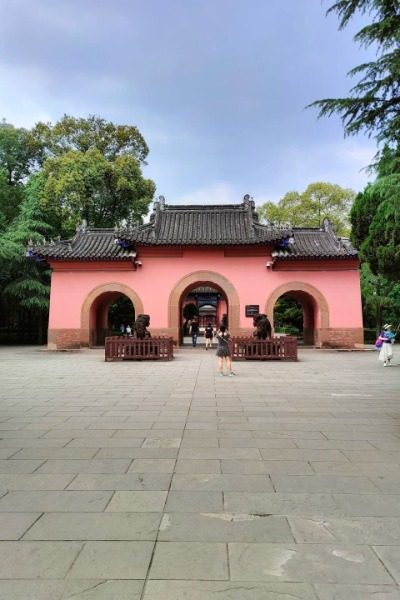
Q&A About the Chengdu Wu Hou Shrine
1. What was the Three Kingdoms period?
The Three Kingdoms period was a time of division and rivalry in Chinese history, roughly spanning from 220 AD to 280 AD. This era was characterized by three main powers: Wei, Shu, and Wu. Wei was the most powerful of the three, controlling a large portion of the Central Plains. Shu was founded by Liu Bei, with its capital in Chengdu, and primarily governed the Sichuan Basin. Wu, established by Sun Quan, mainly dominated the southern regions along the Yangtze River.
2. Who was Zhuge Liang?
The term “Wu Hou” in Chengdu Wu Hou Shrine refers to Zhuge Liang. He was the Prime Minister of the Shu Kingdom during the Three Kingdoms period. As Prime Minister, he was the highest administrative official in the state, assisting the ruler with important national affairs, similar to a modern-day Prime Minister. His responsibilities included managing state affairs, supervising officials, and formulating policies.
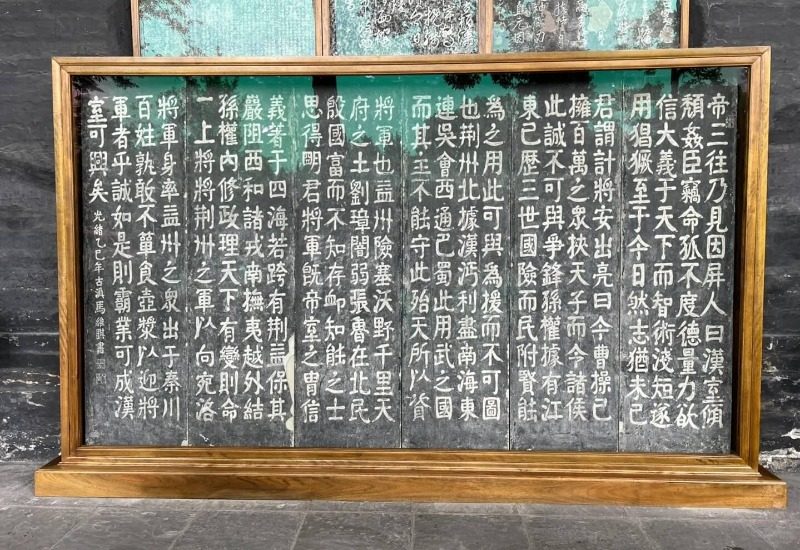
Hours and Fees
Hours
- Daily from 9:00 AM to 6:00 PM, with the last entry at 5:00 PM.
Admission
- 50 CNY per person.
How to Get to the Chengdu Wuhou Shrine
By Bus
- To get to the Chengdu Wuhou Shrine by bus, you can take routes 1, 334, 335, 57, or 82.
By Subway
- To reach the Wuhou Temple Chengdu, you can take either Line 3 or Line 5 of the subway, which intersect at Gaoshengqiao Station. After exiting from Gate A or Gate C, it’s about a 1-kilometer walk to the shrine.
How Visitors Rate the Chengdu Wu Hou Shrine
Local tourists from China
I bought my ticket and hired a guide for about two hours, which was a good decision. The guide started by sharing the story of Zhuge Liang at the entrance, then moved on to explain the Tang inscriptions and other stone tablets in the area. After that, we saw the statues of military generals and civil officials, and finally, we visited Liu Bei's tomb, which is over two thousand years old. Without a guide, if you’re not familiar with the Three Kingdoms, you might find it a bit overwhelming. Right outside the Wuhou Shrine is Jinli Street, a bustling shopping area.


